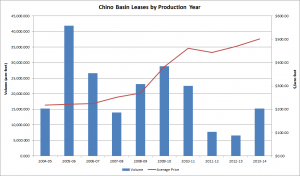A market has developed among members of the Appropriative Pool in the Chino Basin in Southern California. The Chino Basin has a long history beginning with the execution of a Memorandum of Agreement in 1974, a judgement adjudicating the basin in 1978, the development of the Optimum Basin Management Program in 1998, execution of the Peace Agreement in 2000—which established the parties’ intent to implement the Optimum Basin Management Program, and execution of another agreement, known as Peace II—which provided for reoperation of the basin.
The judgement established an initial safe operating yield of 145,000 acre-feet annually, and divided it among three classes of users:
- The Agricultural Pool was allocated 82,800 AF per year.
- The Non-Agricultural Pool, which is composed of commercial and industrial water users, was allocated 7,366 AF per year.
- The Appropriative Pool, which represents cities, water districts and water companies, was allocated 54,834 AF per year.
Water market activity generally occurs in the form of annual leases among members of the Appropriative Pool. The watermaster records two additional types of transfers: 1) transfers that are recorded as the manner of utilizing water company shares and 2) exchanges for water from another basin. These transfers are excluded from JOW’s analysis because they are administrative—not water market—transactions.
Parties enter into leases to meet water supply needs or to offset overproduction. When water is transferred to offset overproduction, a portion of the cost may be subsidized under what is known as the “85/15 Rule.” However, the buyer must be an 85/15 party, and the water must be acquired to offset overproduction. If those conditions are met, then 15% of the lease price is paid by the 85/15 parties collectively. Most of the Appropriators are 85/15 parties; the small number that are not, either opted out or intervened in the judgement later (so they were not original parties to the adjudication).
Over the 10-year period from the FY 2004-05 through FY 2013-14, the volume leased in the Chino Basin varied from year to year—ranging from 6,606.5 AF in FY 2012-13 to 41,908.623 AF in FY 2005-06.
Leasing activity correlates with hydrologic conditions. The years with the three lowest volumes (FY 2007-08, FY 2011-12 and FY 2012-13) were also drought years. Conversely, the years with the two highest volumes (FY 2005-06 and FY 2009-10) were also wetter than normal. 2006 was the last time that the State Water Project provided 100% allocations, and FY 2009-10 saw increased rainfall after the 2007-2009 drought.
The average price rose from $218.37/AF to $501.37 over the 10-year period. Overall, the average annual change was an increase of 10.4% (with a median annual increase of 6.9%).
The highest increase came in FY 2009-10, when the average price rose 42.1% over the previous year. FY 2010-11 saw an increase of 20.7% over FY 2009-10, and FY 2011-12 brought a slight decrease of 3.9%.
The Chino Basin Watermaster is currently overseeing the drafting of a Safe Yield Redetermination and Reset Agreement. If allocations are reduced to meet a new safe yield determination, water market activity could pick up as Appropriators seek to meet water supply needs and offset over-pumping. Meanwhile, expect existing patterns to continue.
Written by Marta L. Weismann
Editor’s Note: This Chino Basin Water Market Indicator is published as a special report in lieu of the Truckee River Surface Water Market Indicator that is on the Journal of Water editorial calendar because the Truckee Meadows Water Authority (“TMWA”) has experienced a delay in the accounting of their data due to the recent acquisition of the Washoe County water system. The Truckee River Surface Water Market Indicator will be published in a later issue after TMWA finishes reconciling its data. An update of the Chino Basin covering activity in FY 2014-15 is still scheduled to appear in December.

You must be logged in to post a comment.